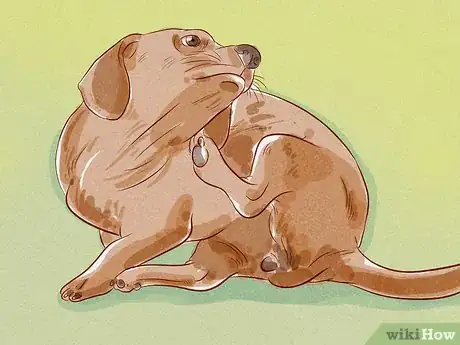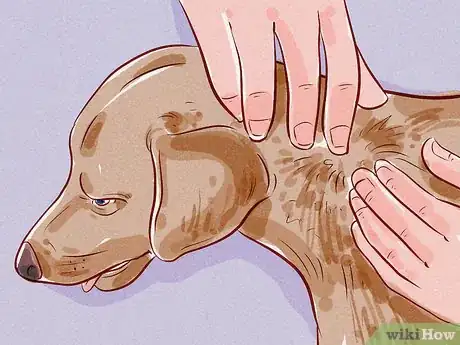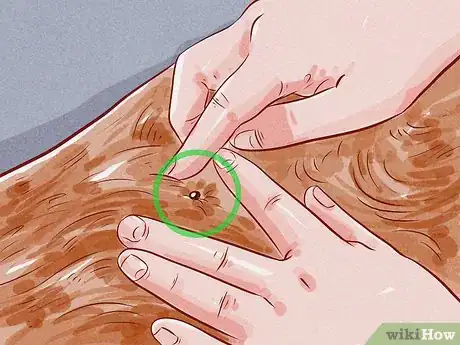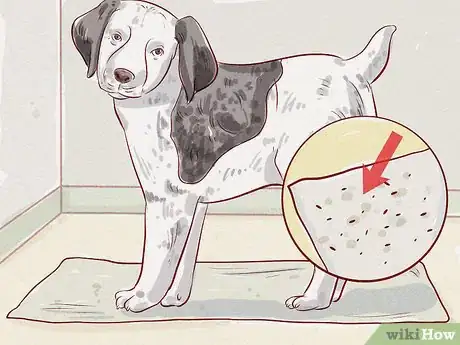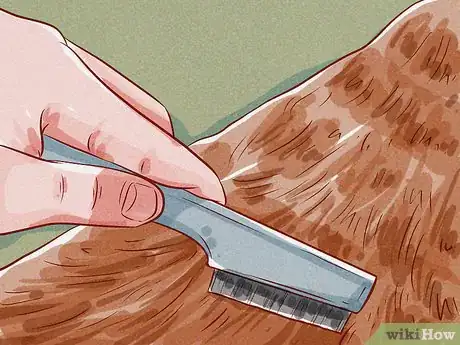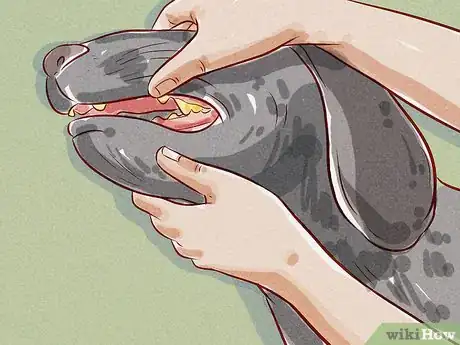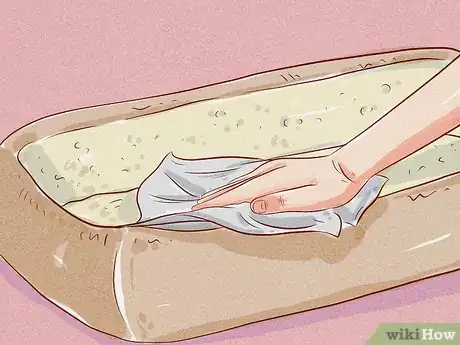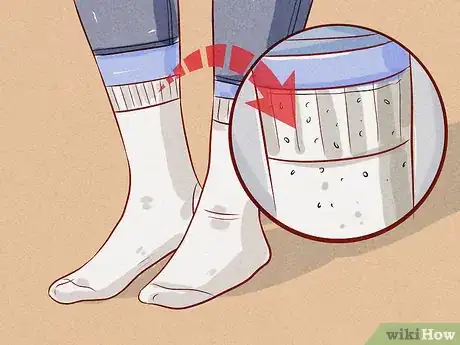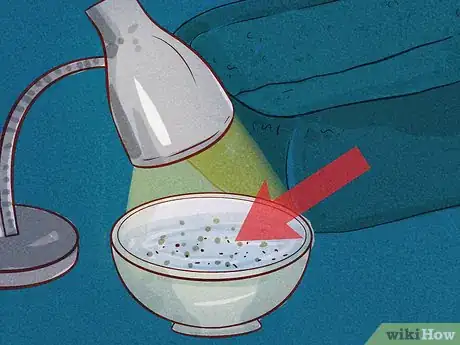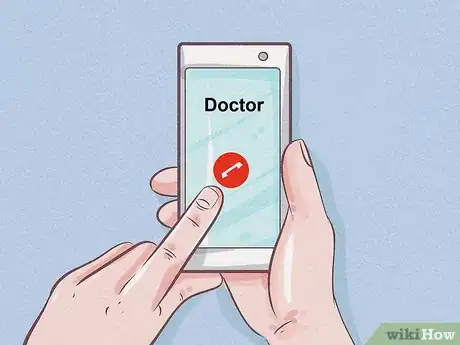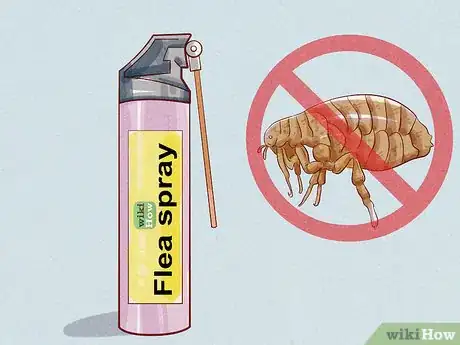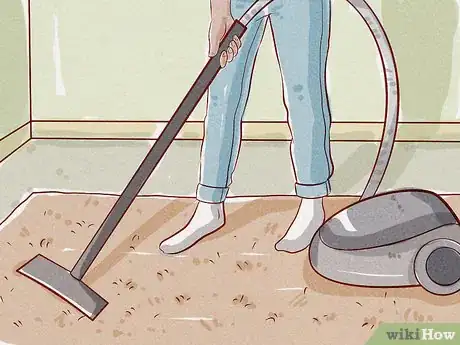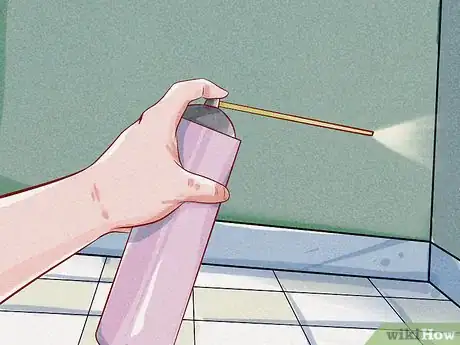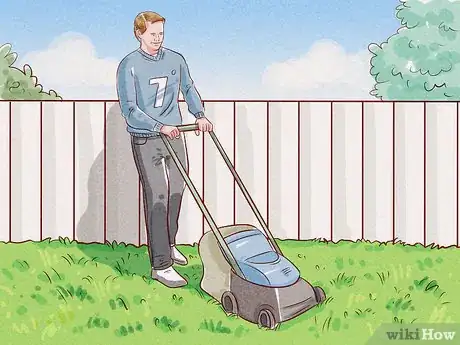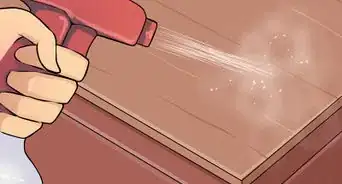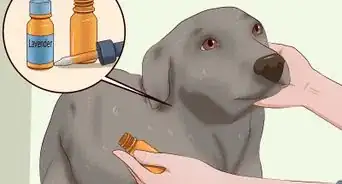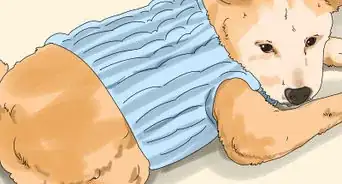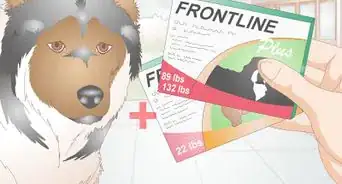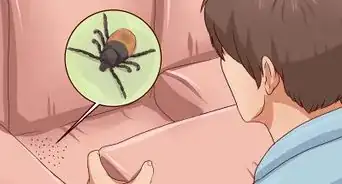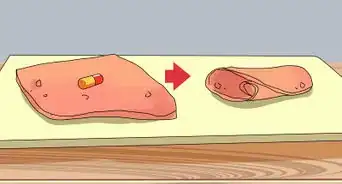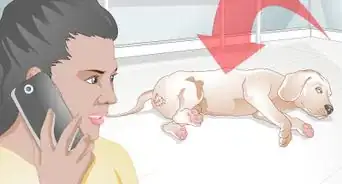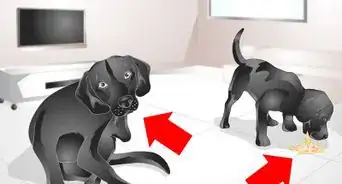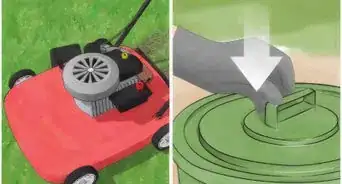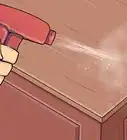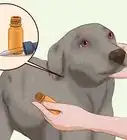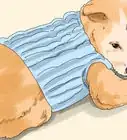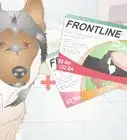This article was co-authored by Ray Spragley, DVM and by wikiHow staff writer, Amy Bobinger. Dr. Ray Spragley is a Doctor of Veterinary Medicine and the Owner/Founder of Zen Dog Veterinary Care PLLC in New York. With experience in multiple institutions and private practices, Dr. Spragley’s specializations and interests include non-surgical management of cranial cruciate ligament tears, Intervertebral Disk Disease(IVDD), and pain management in osteoarthritis. Dr. Spragley holds a BS in Biology from SUNY Albany and has a Doctor of Veterinary Medicine degree (DVM) from Ross University School of Veterinary Medicine. He is also a Certified Canine Rehabilitation Therapist (CCRT) through the Canine Rehab Institute as well as a Certified Veterinary Acupuncturist (CVA) through Chi University.
This article has been viewed 202,748 times.
Fleas are a common parasite that can make your dog itchy and uncomfortable. Not only are they annoying and hard to get rid of, but they can also be dangerous to your dog if they’re left untreated. In most cases, you can tell whether your dog has fleas by watching its behavior, performing a visual check during grooming, and examining your environment for signs of the fleas or their droppings.
Steps
Examining Your Dog for Fleas
-
1
-
2Examine your dog’s skin for tiny, red, raised bumps. Flea bites are usually smaller than other insect bites. This means they can be hard to spot, so you’ll have to look carefully.[4]
- Some dogs may have a stronger reaction to a flea’s saliva, causing a larger red area and more severe irritation.[5]
- You may notice small red dots on your own skin, which could also be flea bites.
Advertisement -
3Check your dog’s fur to spot adult fleas. Use your fingers to part your dog's fur so that you can see its skin, looking for signs of adult fleas. Fleas tend to prefer the base of the tail, the abdomen, and behind the ears, but they can be found anywhere on the dog.[6]
- Adult fleas are about the size of a pencil lead. They are small, flat-bodied insects, and they range in color from reddish-brown to black.
- Keep in mind that fleas will move away from your fingers as you search your dog's fur, making them hard to spot.
- Most fleas live in the environment around the dog, so they may be hard to find in your dog's fur if it only has a mild infestation.
-
4Have your dog stand on a white towel and brush its coat. Brushing your dog may agitate any fleas which might be present. If they jump off of your dog, you should be able to easily spot them on the white towel.[7]
-
5Use a flea comb and soapy water to check your dog’s coat for flea dirt. Place the flea comb on your dog's coat, then apply slight pressure until the comb comes in contact with your dog's skin. Carefully brush through your dog's coat, making sure the comb stays in contact with its skin through the entire stroke.[8]
- After each pass, examine the comb for fleas and flea dirt, then dip the comb into a bowl of warm soapy water to clean the comb.
- Flea dirt, or flea droppings, look like small black flecks, but they actually contain dried blood. If you dip the flea comb into a bowl of soapy water, you should see the flecks slowly change back to red.[9]
- If the flecks remain black after being added to water, it’s probably regular dirt.
- You can also place the flecks on a damp cotton pad and monitor them to see if they change color. If a rusty red halo forms around the flecks, it's a sign that the flecks are flea dirt.
-
6
Checking Your Environment
-
1Examine your dog’s bedding and food area for flea dirt. If you see small black flecks on your dog’s bedding, wipe them up with a damp, white washcloth or paper towel. If they start to turn red after a few minutes, the flecks are flea dirt.[12]
- Check around your dog’s bedding, its food area, and wherever it spends a lot of time.
- You may also see adult fleas in the area.
-
2Wear white socks and walk near the dog's bedding. If there are fleas or flea dirt present, they will get trapped on the socks, making it easy for you to see them.[13]
-
3Make a light trap with a bowl of water and a nightlight. Set a small bowl of soapy water on the floor near your dog’s bedding and turn on a nightlight. If there are fleas in the area, they will be drawn towards the light, causing them to jump into the soapy water and drown.[14]
- You may want to keep your dog in a kennel or in a separate area overnight so it doesn’t attempt to drink the soapy water.
Treating Fleas
-
1Contact your veterinarian if your dog has fleas. Your veterinarian will recommend a specific treatment plan for your household. You will need to treat all of your animals, including indoor and outdoor cats.[15]
- Common options for killing fleas include a monthly treatment applied to the back of the dog’s neck, as well as shampoos, sprays, and powders.
- It’s important to create a treatment plan that is specific to your dog and its environment, because using certain products in combination with each other can be toxic to your pet.
-
2Try store-bought or natural remedies to kill fleas. Store-bought flea sprays and powders can be an effective way to kill fleas on your dog, in your dog's bedding, and throughout your home. You may also be able to discourage fleas from settling on your dog by dipping your dog's brush in lemon juice before you comb its fur.
-
3
-
4Spray or fog your home with flea-killer to get rid of severe infestations. These chemicals are extremely dangerous, so they should only be used if you can’t get rid of the fleas any other way.[18]
- Some flea killers come in the form of aerosol sprays, while bug bombs or foggers release on their own once you have activated them. This gives you time to leave the area so you’re not exposed to the chemicals.
- Wear a face mask to protect yourself while you’re using these chemicals, or have a professional exterminator come to your home.
- You will need to temporarily evacuate your home during this process, so have a plan for what you will do with your dog and other animals. This evacuation is usually about 3-6 hours, but be sure to read the label carefully to be sure.
-
5Mow the grass in your yard once a week to keep the grass short. Mowing the grass will help prevent fleas from jumping onto your dog when it spends time outdoors.
- Fleas prefer dark places. Mowing the grass exposes them to sunlight, which will help discourage them from infesting your yard.
Expert Q&A
-
QuestionHow do I check my dog for fleas?
 Ray Spragley, DVMDr. Ray Spragley is a Doctor of Veterinary Medicine and the Owner/Founder of Zen Dog Veterinary Care PLLC in New York. With experience in multiple institutions and private practices, Dr. Spragley’s specializations and interests include non-surgical management of cranial cruciate ligament tears, Intervertebral Disk Disease(IVDD), and pain management in osteoarthritis. Dr. Spragley holds a BS in Biology from SUNY Albany and has a Doctor of Veterinary Medicine degree (DVM) from Ross University School of Veterinary Medicine. He is also a Certified Canine Rehabilitation Therapist (CCRT) through the Canine Rehab Institute as well as a Certified Veterinary Acupuncturist (CVA) through Chi University.
Ray Spragley, DVMDr. Ray Spragley is a Doctor of Veterinary Medicine and the Owner/Founder of Zen Dog Veterinary Care PLLC in New York. With experience in multiple institutions and private practices, Dr. Spragley’s specializations and interests include non-surgical management of cranial cruciate ligament tears, Intervertebral Disk Disease(IVDD), and pain management in osteoarthritis. Dr. Spragley holds a BS in Biology from SUNY Albany and has a Doctor of Veterinary Medicine degree (DVM) from Ross University School of Veterinary Medicine. He is also a Certified Canine Rehabilitation Therapist (CCRT) through the Canine Rehab Institute as well as a Certified Veterinary Acupuncturist (CVA) through Chi University.
Veterinarian Try combing through their fur to see if there's any black specks called "flea dirt." If you get the flea dirt wet on a paper towel, it will leave a red stain.
Try combing through their fur to see if there's any black specks called "flea dirt." If you get the flea dirt wet on a paper towel, it will leave a red stain. -
QuestionWhat kills fleas on dogs instantly?
 Pippa Elliott, MRCVSDr. Elliott, BVMS, MRCVS is a veterinarian with over 30 years of experience in veterinary surgery and companion animal practice. She graduated from the University of Glasgow in 1987 with a degree in veterinary medicine and surgery. She has worked at the same animal clinic in her hometown for over 20 years.
Pippa Elliott, MRCVSDr. Elliott, BVMS, MRCVS is a veterinarian with over 30 years of experience in veterinary surgery and companion animal practice. She graduated from the University of Glasgow in 1987 with a degree in veterinary medicine and surgery. She has worked at the same animal clinic in her hometown for over 20 years.
Veterinarian Though not "instant," an oral medication called Capstar kills fleas on dogs within minutes.
Though not "instant," an oral medication called Capstar kills fleas on dogs within minutes. -
QuestionHow do you know if your dog has fleas?
 Pippa Elliott, MRCVSDr. Elliott, BVMS, MRCVS is a veterinarian with over 30 years of experience in veterinary surgery and companion animal practice. She graduated from the University of Glasgow in 1987 with a degree in veterinary medicine and surgery. She has worked at the same animal clinic in her hometown for over 20 years.
Pippa Elliott, MRCVSDr. Elliott, BVMS, MRCVS is a veterinarian with over 30 years of experience in veterinary surgery and companion animal practice. She graduated from the University of Glasgow in 1987 with a degree in veterinary medicine and surgery. She has worked at the same animal clinic in her hometown for over 20 years.
Veterinarian The biggest clue is to look for flea dirts. Part the dog's coat and look for black specks, and place one on damp cotton wool. An orange halo means it's a flea dirt.
The biggest clue is to look for flea dirts. Part the dog's coat and look for black specks, and place one on damp cotton wool. An orange halo means it's a flea dirt.
Warnings
- Wear a face mask to protect yourself while you’re using flea spray or foggers, or have a professional exterminator come to your home.⧼thumbs_response⧽
- Never use flea products on your dog that are intended to treat cats.⧼thumbs_response⧽
Things You'll Need
- Brush
- White towel
- Flea comb
- Bowl of soapy water
- Nightlight
- Flea medicine
References
- ↑ Ray Spragley, DVM. Veterinarian. Expert Interview. 31 March 2021.
- ↑ http://www.akc.org/expert-advice/health/flea-tick/flea-bites-on-dogs/
- ↑ https://pets.webmd.com/dogs/guide/fleas-dogs-what-look-for#1
- ↑ http://www.akc.org/expert-advice/health/flea-tick/flea-bites-on-dogs/
- ↑ http://www.akc.org/expert-advice/health/flea-tick/flea-bites-on-dogs/
- ↑ https://pets.webmd.com/dogs/guide/fleas-dogs-what-look-for#1
- ↑ https://www.petmd.com/dog/parasites/evr_dg_does_my_dog_have_fleas
- ↑ http://www.akc.org/expert-advice/health/flea-tick/flea-bites-on-dogs/
- ↑ Ray Spragley, DVM. Veterinarian. Expert Interview. 31 March 2021.
- ↑ https://pets.webmd.com/dogs/guide/fleas-dogs-what-look-for#1
- ↑ https://pets.webmd.com/dogs/guide/fleas-dogs-what-look-for#1
- ↑ https://www.petmd.com/dog/parasites/evr_dg_does_my_dog_have_fleas?page=2
- ↑ https://www.petmd.com/dog/parasites/evr_dg_does_my_dog_have_fleas?page=2
- ↑ https://www.petmd.com/dog/parasites/evr_dg_does_my_dog_have_fleas?page=2
- ↑ https://pets.webmd.com/dogs/guide/fleas-dogs-what-look-for#1
- ↑ https://pets.webmd.com/dogs/guide/fleas-dogs-what-look-for#1
- ↑ https://www.aspca.org/pet-care/general-pet-care/fleas-and-ticks
- ↑ https://pets.webmd.com/dogs/guide/fleas-dogs-what-look-for#1
About This Article
To tell if your dog has fleas, observe them to see if they're itching, biting, or chewing any part of their body excessively. If they are, examine that area of their skin to see if there are red, raised bumps, which are flea bites. Look in your dog's fur around their ears, on their abdomen, and near their tail for adult fleas, which are about the size of a small piece of pencil lead and can be reddish-brown or black. If you're not sure, have your dog stand on a white towel or sheet, and brush their fur to see if any brown flakes fall off, which are fleas jumping from the dog onto the towel. For tips from out veterinary reviewer on checking your home for fleas and getting rid of them, scroll down!
